Implementation Techniques for Multimedia Storage Servers and Networking
(Spring 1999)
Tzi-cker Chiueh
Group members
| Susanne Cech |
9560316 |
Michael Kropfberger |
9555885 |
| Johannes Kosche |
9560368 |
Hannes Tschofenig |
9460247 |
Table of Contents
Project Goal
Introduction
Design Decisions
Implementation Details
Performance Analysis
Project Goal
Implementation of a user-level real-time network storage server with the
following specifications:
-
Clients make request through BSD-style sockets.
-
Each request is of the form "get file_name file_offset required rate".
-
The server implements a cyclic scheduling.
Introduction
The main idea of a real-time network storage server is to deliver files
at a specified rate to a number of clients. Traditionally, a client-server
architecture is used.
Our server consists of several parts, such as a disk storage subsystem
and a control unit, which is responsible for the admission control and
the scheduling of the request. The admission control module decides
if the server can satisfy a new request for the entire connection.
Cyclic scheduling means that within one cycle the required media blocks
of all streams are retrieved from disk and sent to the clients.
Constraints of a user-level real-time network storage server:
-
We can not guarantee exact retrieval times from the disk subsystem, because
we are not able to influence data placement on disk, seek times, disk scheduling,
etc.
-
A non real time operating system (like Linux or Windows NT) can not guarantee
an accurate runtime for a user level program. This is primarily due to
interrupt handling and process scheduling.
-
A regular Ethernet uses CSMA/CD for its arbitration process. This basically
means that we can only offer a best effort strategy instead of a
QoS based approach. This is a limitation for the usage of our network storage
server as far as end to end delivery guarantees are concerned. On the other
hand most of the computer user today do not have a QoS network infrastructure.
Design Decisions
1. Server Push vs Client Pull Model
For our purpose, a server push model seemed to be well suited, because
it simplifies the admission control implementation.
2. Admission Control
Our admission control is based on statistical averaging. To be able
to decide whether to allow a new request to join or not is based on measured
time consumtions of acutal fullfilled requests of past cycles. The
basic assumption behind this averaging is that we use historic calculated
requirements to predict the future requirements.
To be more formallly, the following equation must be satisfied:
R = R1 + R2 + ... +Rn
+ O < P (I/O cycle)
Ri.. time for request i per I/O cycle
O.. additional overhead
P.. maximal time bound for one I/O cycle
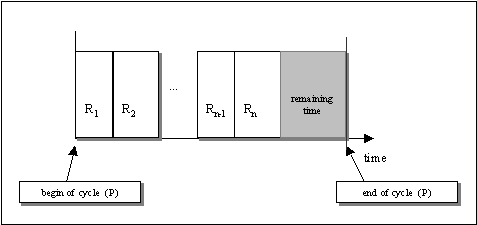
Figure 1. Ideal cycle.
If all requests are satisfied within the current cycle and time is left,
there are two possibilities to deal with this problem: Either the server
waits in a loop (busy waiting), which is CPU intensive, or it sleeps until
the end of the cycle. The operating system is responsible for waking the
server, which cannot be that exact. As a consequence, the process might
sleep longer as required [Figure 2] and therefore the next cycle-time is
shortened by the time it slept too long[Figure 3].
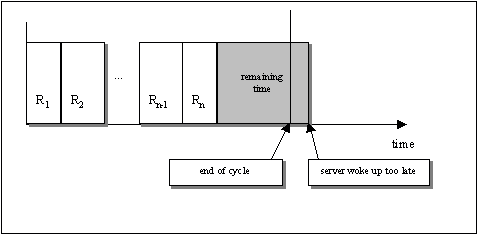
Figure 2. Process sleeps too long.
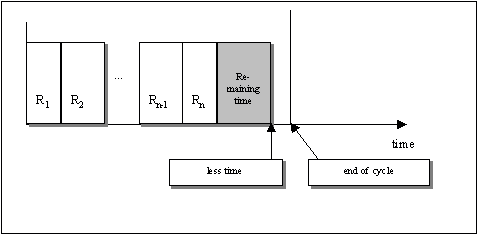
Figure 3. Thus, next cycle is shorter.
Implementation Details
Used data structures:
typedef struct mm_client {
struct sockaddr_in client;
// socket address
char
hostname[STRLEN]; // hostname for convenience
int
port; //
port number for convenience
char
file[STRLEN]; // requested file
FILE
*fp;
// file pointer
long
fpos; //
starting offset within file
long
rate; //
rate in bytes per second
long
usecs;
// time of last serve
long
avg_usecs; // average
time of previous serves
struct mm_client
*prev;
struct mm_client
*next;
} mm_client;
Listing 1. List structure for client requests
typedef struct mm_stats {
float avg_bytes_per_usec;
//
average bytes per usec over the server's life time
long sum_usecs;
// sum of all usecs used for clients in this I/O cycle
long avg_sum_usecs;
// average sum of usecs used for clients over the server's life
time
long sum_bytes;
// sum of all bytes sent in this I/O cycle
int num_clients;
// number of concurrent clients
long remaining_time;
// time left in actual I/O cycle
long adjust;
// time server slept too long
long avg_adjust;
// average of adjusts
long algo_time;
// time used for general code parts
long cycles;
// number of cycles
long working_time;
// time spent on serving all clients in this cycle
long sum_working_time;
// sum of all working times spent over the server's life time
} mm_stats;
Listing 2. Data structure for statistics.
Main server layout:
-
Server runs in an infinite loop waiting for incoming requests.
-
The client transmits a request by a "hello" packet using UDP/IP.
The request consists of a number of parameters:
- The requested file
- The file offset
- The required rate (bytes per second)
This incoming request is added to a doubly linked list [listing 1]
if the admission control module accepts the request..
-
After new requests are added to the list, the server processes the list
elements and sends the media blocks at the wanted rate of each stream,
cycle per cycle.
-
When the last block of the required file has been sent, the list entry
of this client is dequeued
-
When all clients are done, the remaining time is slept, to get one second
per cycle
-
then, some statistics (eg. the adjust value) are gained
Sources:
mm_prot.h
mm_server.c
mm_client.c
Performance Analysis
Test Environment
Operating system:
Linux 2.0.36 Kernel
Hardware:
CPU: PII 450MHz
RAM: 256MB
HDD: IBM DGHS18U/17.5GB/SCSI
SCSI Controller: Adaptec AHA2940
Network: Intel EtherExpress Pro (100MBit)
Clients:
always requested a rate of 1.5 MBit/sec
Caveats:
All those tests imply a completely unused network and close-to-idle CPUs.
Other network load would increase collisions and thus influence the
time needed to serve a request.
Also a high CPU usage of other concurrent processes (and most of all
concurrent file access) would increase the time needed to serve a request.
Test Results
Figure 4 shows how the number of accepted clients decreases when distinct
files are requested for streaming.
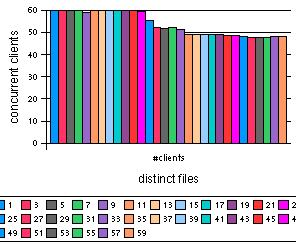
Figure 4. variable client requests and increasing number of distinct
files
Figure 5 shows fixed client requests (45 clients) and increasing
distinct files.
The increasing number of distinct files leads to an increase of microsecs
spent on each client to fulfill the wanted rate.
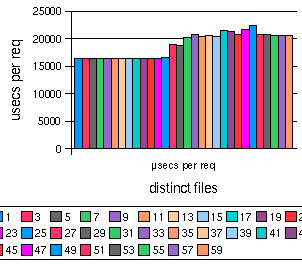
Figure 5. fixed client requests (45 clients) and increasing
number of distinct files





